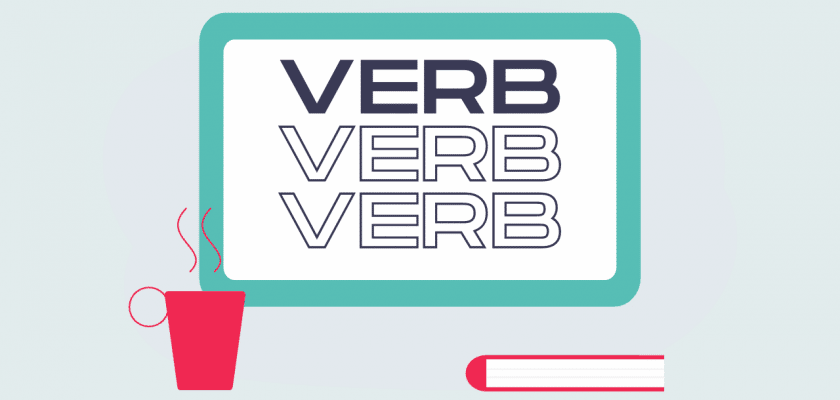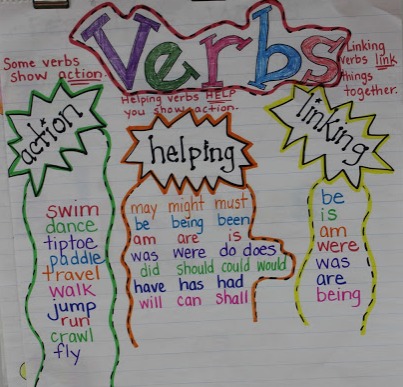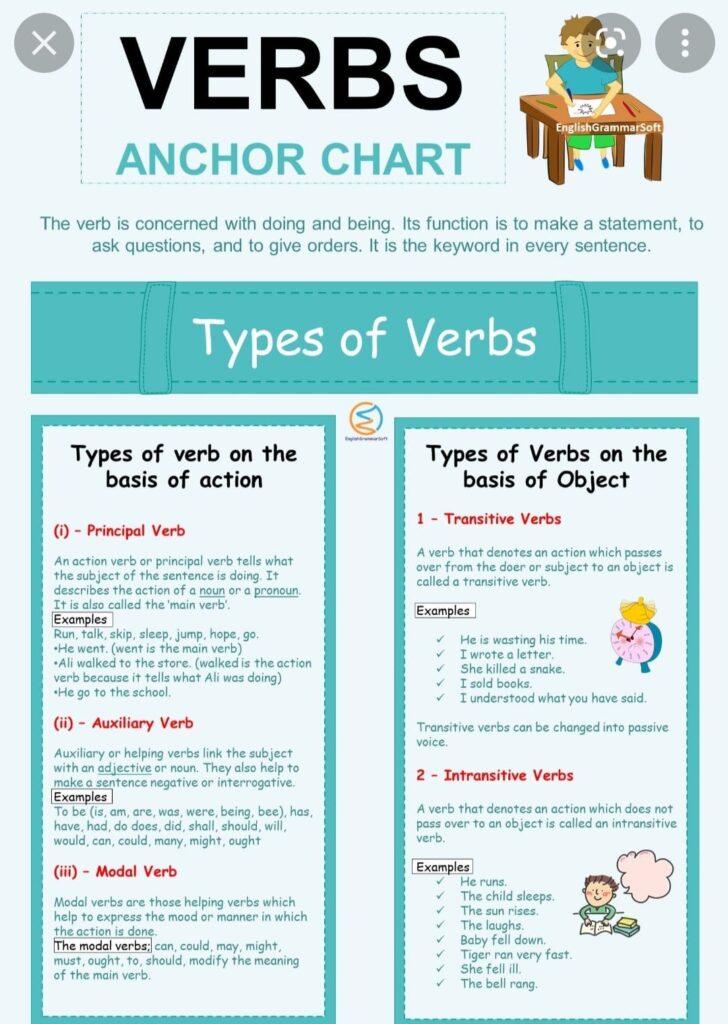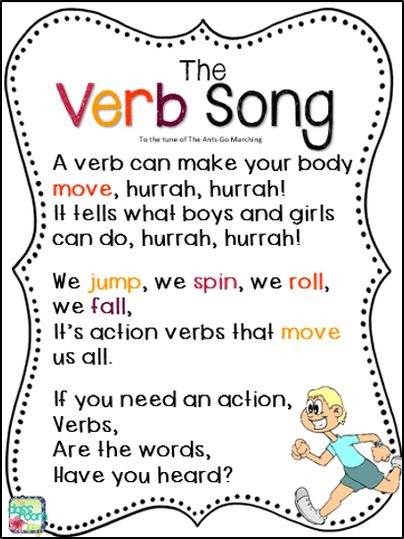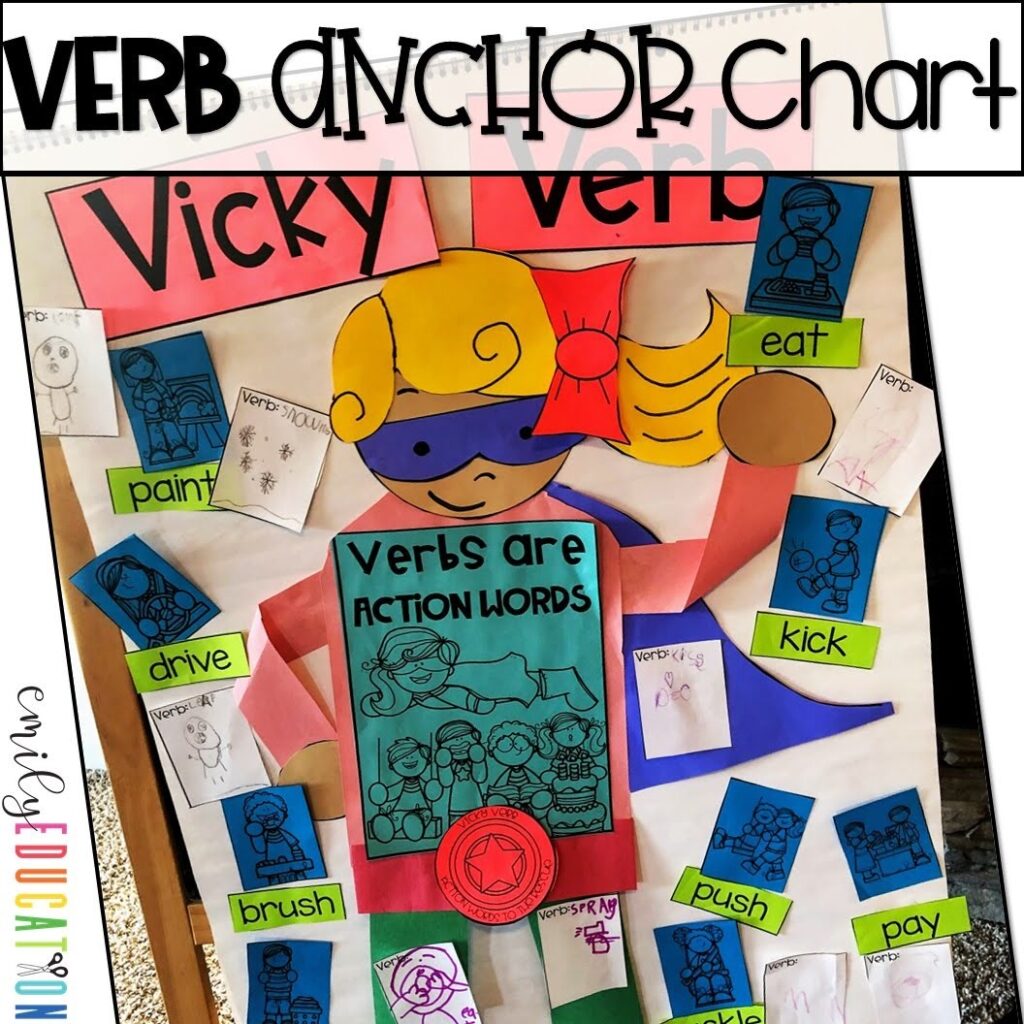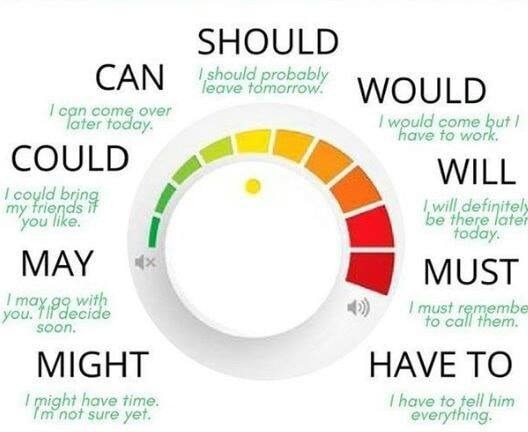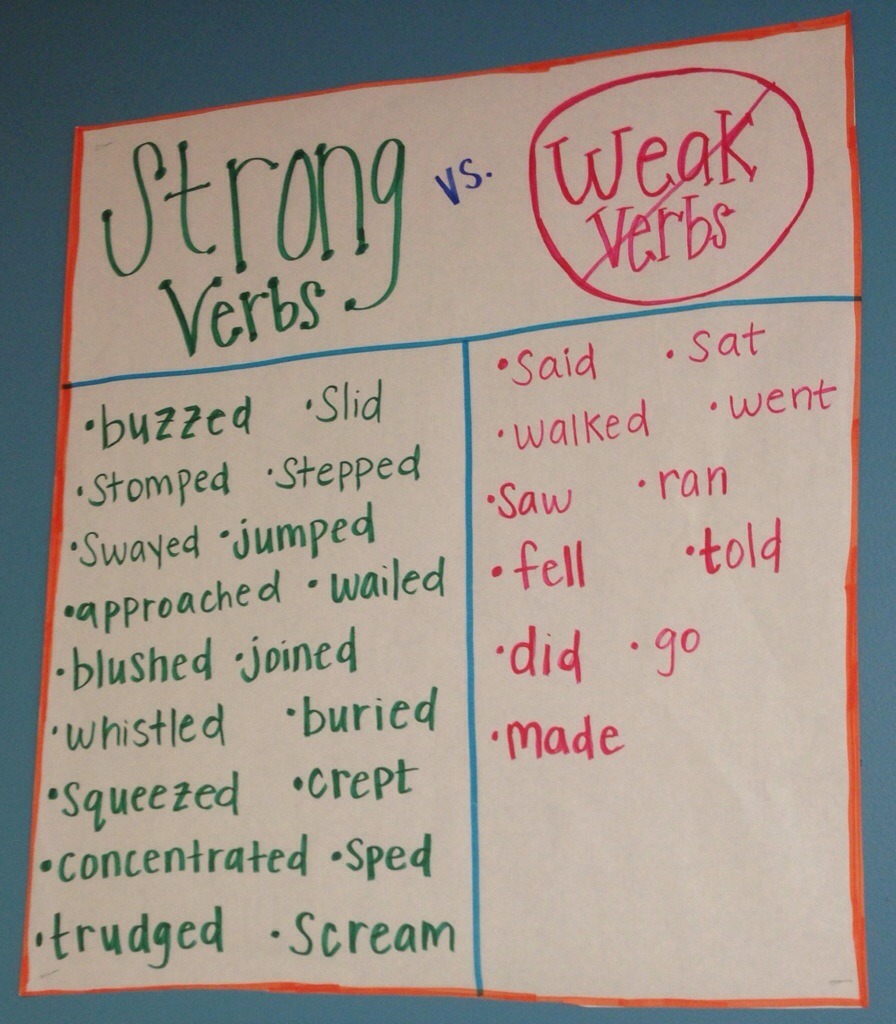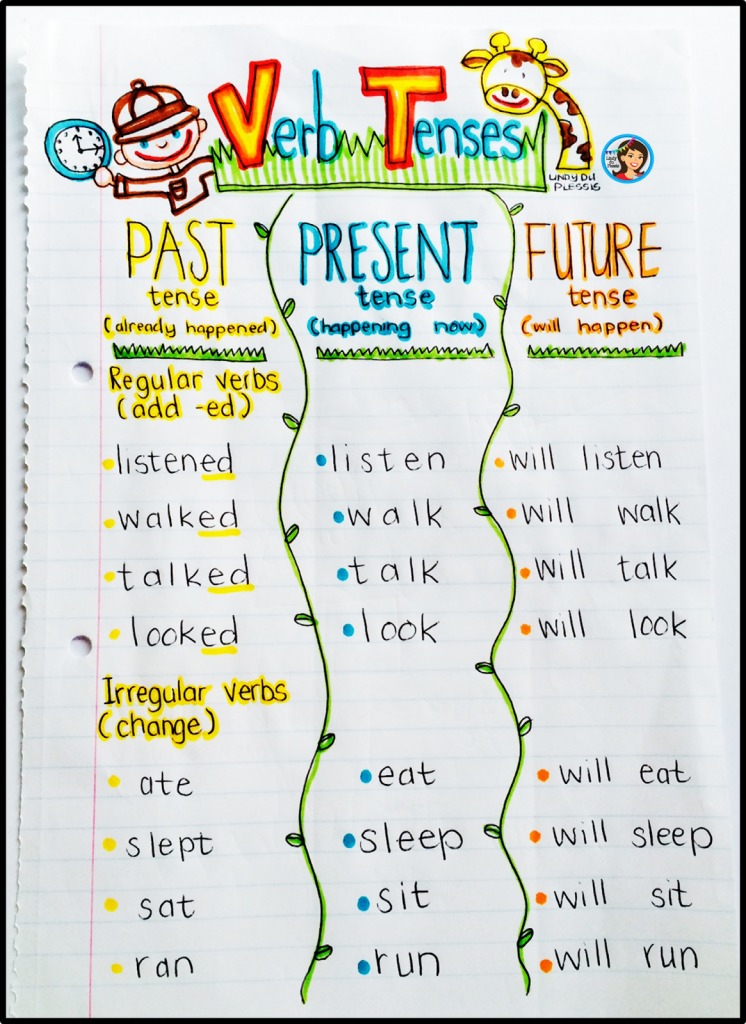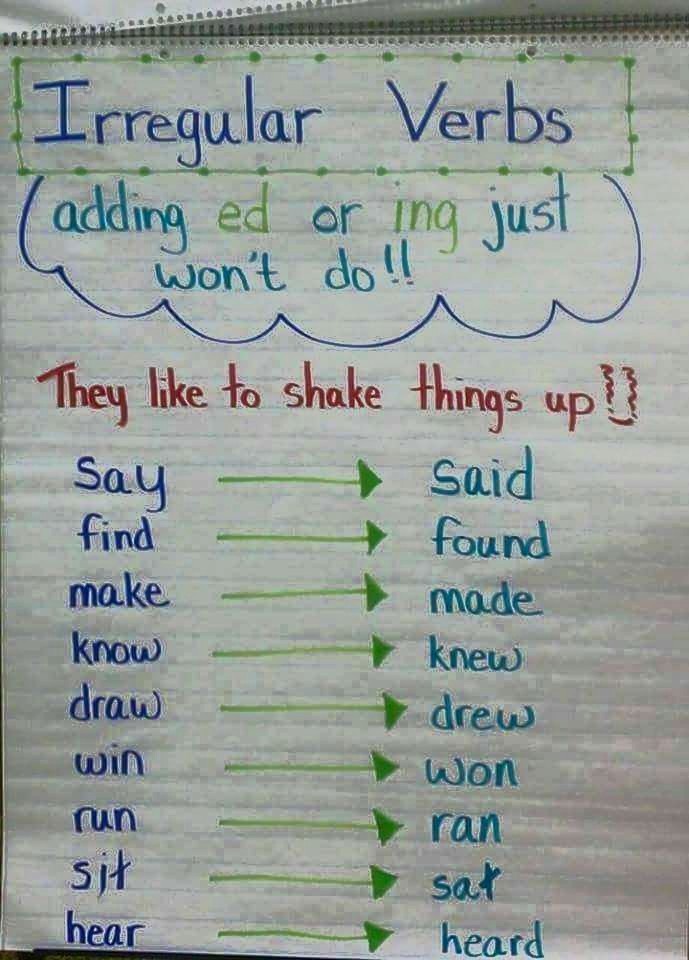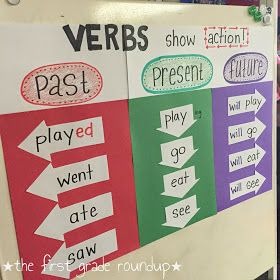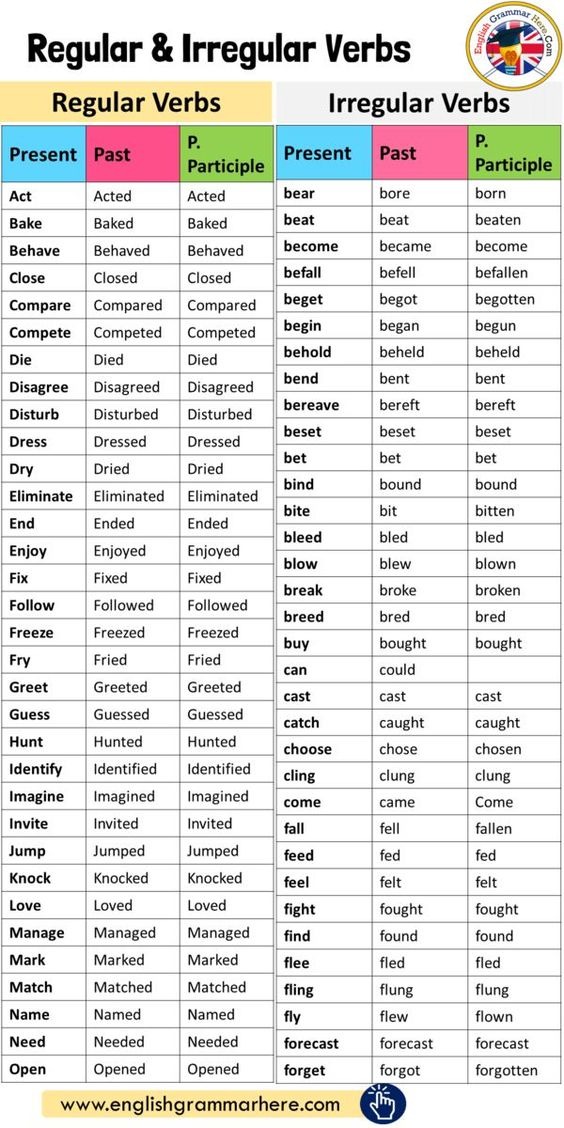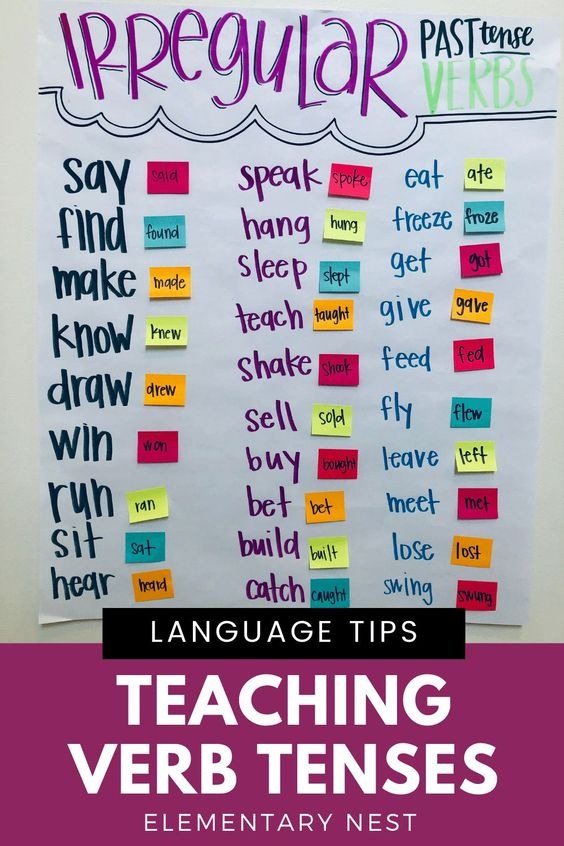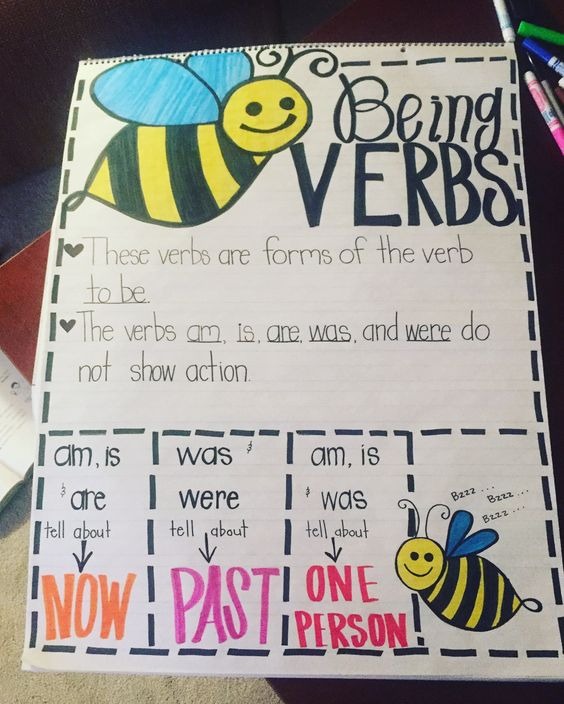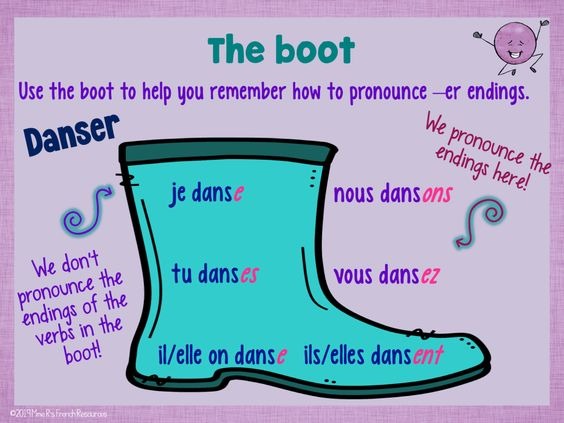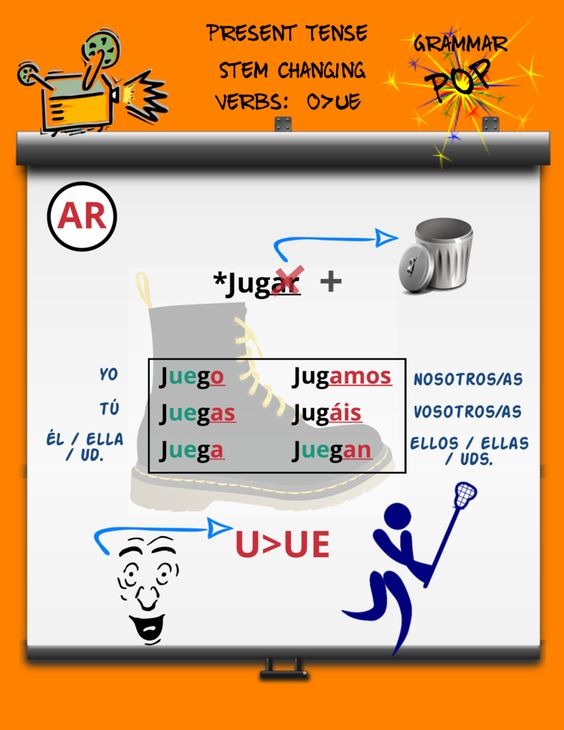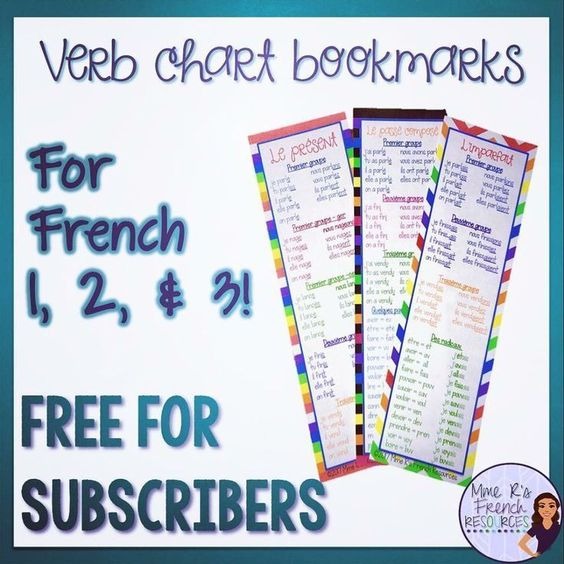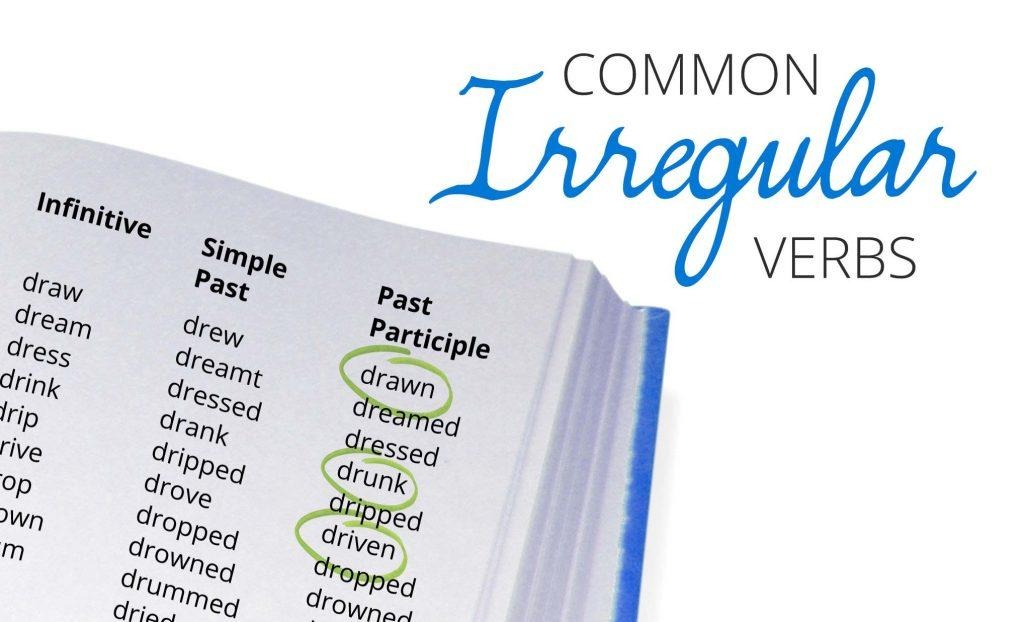With so much information your students have to learn, it’s helpful to provide them with anchor charts. Anchor charts are a way of displaying information at a glance on one specific topic.
There is a lot to cover when it comes to verbs, the parts of a sentence that express an action, state of being, or occurrence. Let’s break down how to make an effective anchor chart for verbs.
Table of Contents
- What Elements Need to Go Into a Good Verb Anchor Chart?
- Verb Anchor Chart Resources from Teach Simple
- Examples of Verb Anchor Charts from Different Teachers
- Make Verb Anchor Charts with Your Students
- Find Somewhere Ideal to Display Your Verb Anchor Chart
- Final Thoughts
What Elements Need to Go Into a Good Verb Anchor Chart?
First, you’ll need to decide what specific information about verbs you want to share with your students. It would be way too much to try to include everything your students need to know about verbs into one anchor chart. Here are some ways to organize topics you can succinctly cover in a single verb anchor chart:
Choose One Simple Topic for a Verb Anchor Chart
Definitions and Examples of Action, Helping, and Linking Verbs
It can be hard to understand what it means when we describe verbs as either “action,” “helping,” or “linking.” It’s a great idea to provide an anchor chart that breaks verbs into these three categories and then gives examples of each.
1. Examples of Juicy Verbs
Students can get stuck in a rut of using too many basic verbs. This can make writing repetitive and boring. To help students with their creative writing, you may want to provide an anchor chart that lists examples of juicy, “$10” verbs to help unleash their creativity.
2. Conjugating Regular Verbs
Verbs need to be conjugated into different tenses to follow the rules of grammar. There are three main verb tenses: past, present, and future. For each tense, there are four more delineations: simple, perfect, continuous, and perfect continuous. That makes for 12 tenses total in the English language. Woofta! Students can benefit greatly from an anchor chart that demonstrates how to conjugate regular verbs.
3. Conjugating Irregular Verbs
As many ways as there are to conjugate regular verbs, English is also full of irregular verbs. Students can benefit from a display in the classroom that defines and shows examples of irregular verb conjugation. Frankly, a lot of us gownups may appreciate a reminder for some of the irregular verbs, as well!
Displaying the Information
Now that you’ve settled on what you need to demonstrate in your verb anchor chart, consider the following elements to make it the best it can be:
Title
The title needs to reflect the information displayed in the chart clearly. It should also be succinct. If you can make it witty, eg, with humor or alliteration, all the better!
Learning Objective
Explain what information the anchor chart will convey. You can use a smaller font to go into more depth than you did in the title.
Imagery
Include visuals that help convey the meaning displayed on the anchor chart.
Color
Remember to make it colorful so that it can be eye-catching. Use color in a way that enhances meaning rather than distracting from it.
Short
An anchor chart should not include any more than a page’s worth of information. Remember, they function as a quick reference guide.
Clear
Make sure the layout is clear, and the information is presented in a way that is quick and easy to grasp at a glance.
Verb Anchor Chart Resources from Teach Simple
Verbs Anchor Chart By First in Line
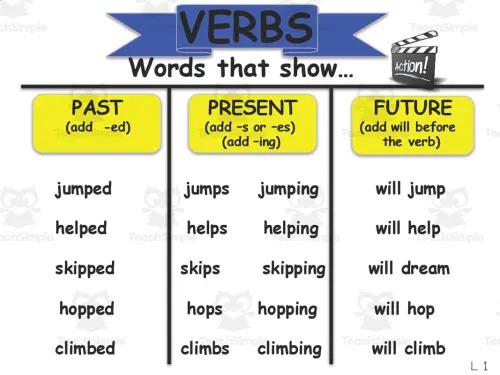
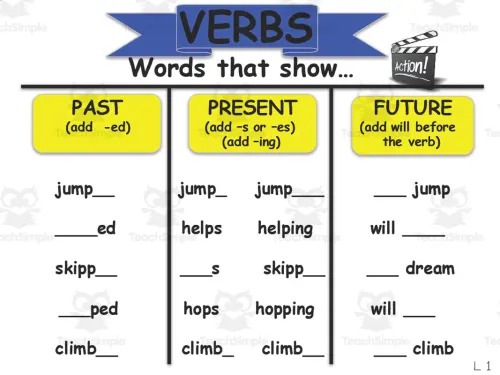
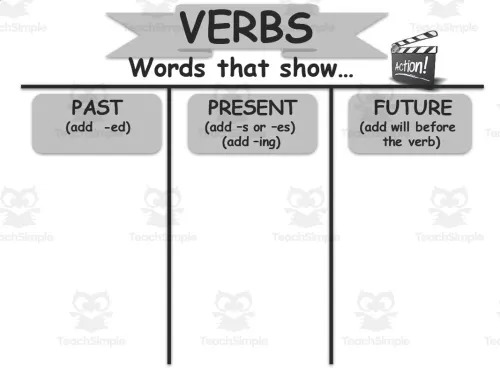
Suitable for students in kindergarten through 3rd grade, this verb anchor chart includes three different versions. The first is a complete verb anchor chart detailing past, present, and future for five regular verbs. The second chart is partially complete so students may practice by filling it in, and the last chart is a fully blank version of the chart for students to fill out.
Anchor Charts Professional Development By Sheltered Language Resources
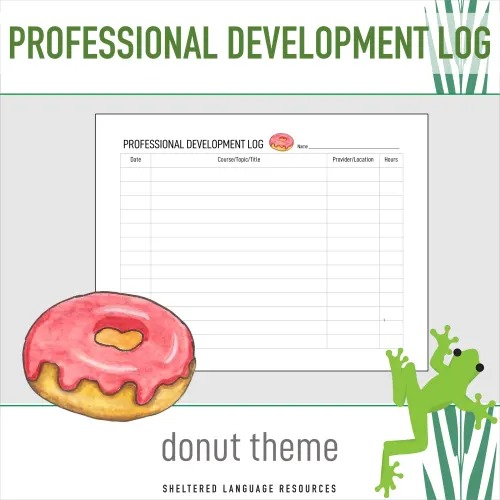
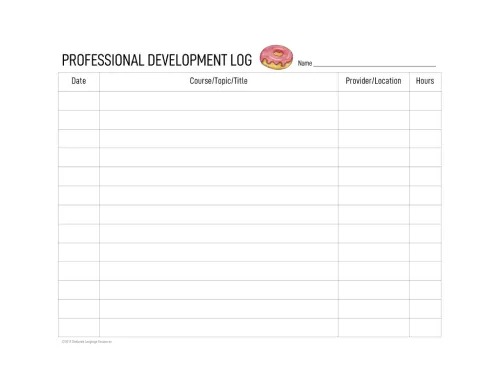
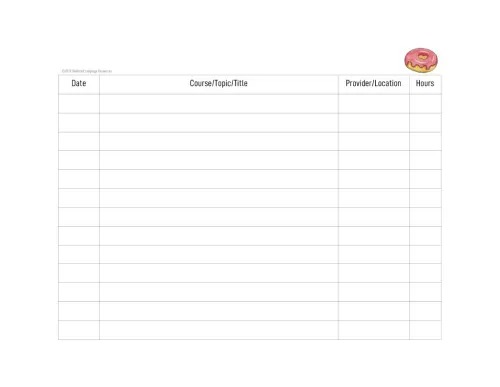
Do you need to help other teachers learn to utilize anchor charts? This resource is a 12 page PowerPoint to help you demonstrate what anchor charts are and the benefits of teaching with them.
Examples of Verb Anchor Charts from Different Teachers
Definitions and Examples of Different Categories of Verbs
Basic Types of Verbs By From Langford
This simple verb anchor chart divides examples of verbs into three columns: “Action,” “Helping,” and “Linking.”
In-Depth Types of Verbs From Basic information in English language
If you want students to go more in-depth into what the types of verbs are, this anchor chart defines verbs on the basis of action or object. It explains principal, auxiliary, and modal verbs, as well as transitive and intransitive verbs.
Linking Verbs From Crafting Connections
This anchor chart defines linking verbs and provides example sentences. It also includes columns of true linking verbs and sometimes linking verbs. As a bonus, her blog post also includes a free worksheet you can download for helping students differentiate between linking verbs and action verbs.
Helping Verbs Song From I Teach For Kids
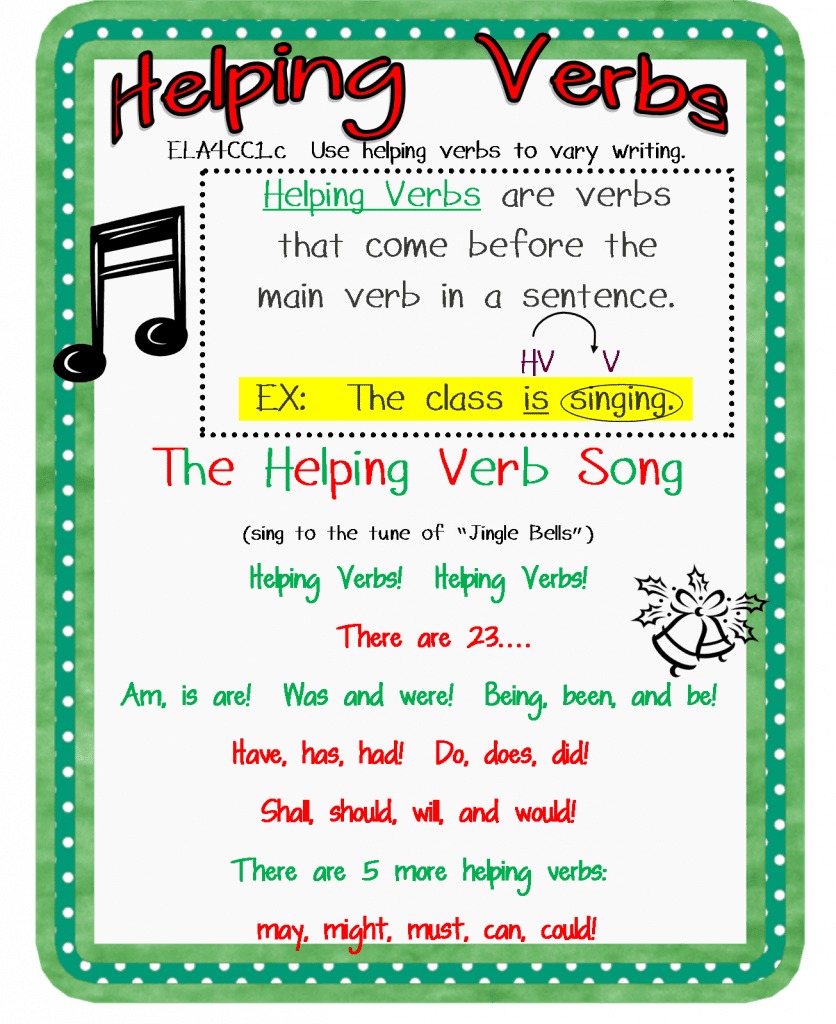
To be sung to the tune of “Jingle Bells!” This is a really creative way to help students learn what the helping verbs are. The use of singing paired with the use of a well-known song is a great memorization tool. Plus, this just makes it more fun!
Action Verbs Song From The Classroom Key
Here’s another song to help make learning verbs easier as well as more memorable and fun. This song describes and demonstrates what action verbs are. It is sung to the tune of “When Johnny Comes Marching Home.”
Action Verb Anchor Chart From Emily Education
This aesthetic anchor chart gives examples of action verbs and uses some in example sentences.
Anchor Chart for Action Verbs From Scholastic
This is also a really simple list of action verbs with some nice drawings of some of the actions to help demonstrate their meaning visually.
Progressing Helping Verbs From My Easy English Tips
Modal, or helping verbs, are laid out in a logical progression using a creative and simple layout in this verb anchor chart.
Strong vs Weak Verbs From Texas Teaching Fanatic
Here you’ll see two columns listing both a basic way to express an action, and a potentially stronger verb choice to consider.
Conjugating Verbs
Conjugating Regular Verbs From Lindsay Loves To Teach
Examples of a few regular verbs conjugated for past, present, and future tenses. Bonus points to this anchor chart for featuring Violet from The Incredibles demonstrating regular verb conjugation by saying, “I can do anything!”
Conjugating Irregular Verbs From Super ESL Teaching Resources
This one is great because it has the definition of an irregular verb at the top and presents it in a way that’s both informative and fun.
Basic Regular and Irregular Verb Conjugation The First Grade Roundup
This chart displays a short list of both regular and irregular verbs, and how they are conjugated into past, present, and future tenses.
100 Examples of Regular and Irregular Verbs in English From English Grammar Here
A more in-depth list displaying a mix of regular and irregular verbs conjugated into different tenses.
Irregular Verbs Sticky Notes Anchor Chart From Elementary Nest
Students can not only benefit from having this anchor chart on display in the classroom, but the sticky notes present a means for them to practice conjugating irregular verbs over and over as well.
Conjugating “To Be” From Bored Monday
This is a simple anchor chart for the different ways to conjugate the common verb, “to be.” This chart is great for its simplicity, as well as its very cute bee design!
Teaching French “-er” Verbs with The Boot Mme R’s French Resources
Not only do students learning French need to learn how to conjugate verbs, they need to learn the rules for pronunciation that go along with them. This anchor chart uses “the boot” method to display the rules for conjugating and pronouncing -er verbs in French using “danser” as an example.
Teaching Spanish Verbs with The Boot From Speak More Spanish
Yes, “the boot” works for Spanish, too! Here is a verb anchor chart demonstrating with the Spanish verb, “jugar.”
Free Resources
Free French Language Verb Chart Bookmarks From Mme R’s French Resources
How cool is this? If you subscribe to this French teacher’s newsletter, you’ll receive these French Verb bookmarks. Perfect for French students who need a quick reminder perhaps, saved in their copy of Le Petit Prince.
Free Spanish Language Verb Charts PDF Downloads From Spanish with Tati

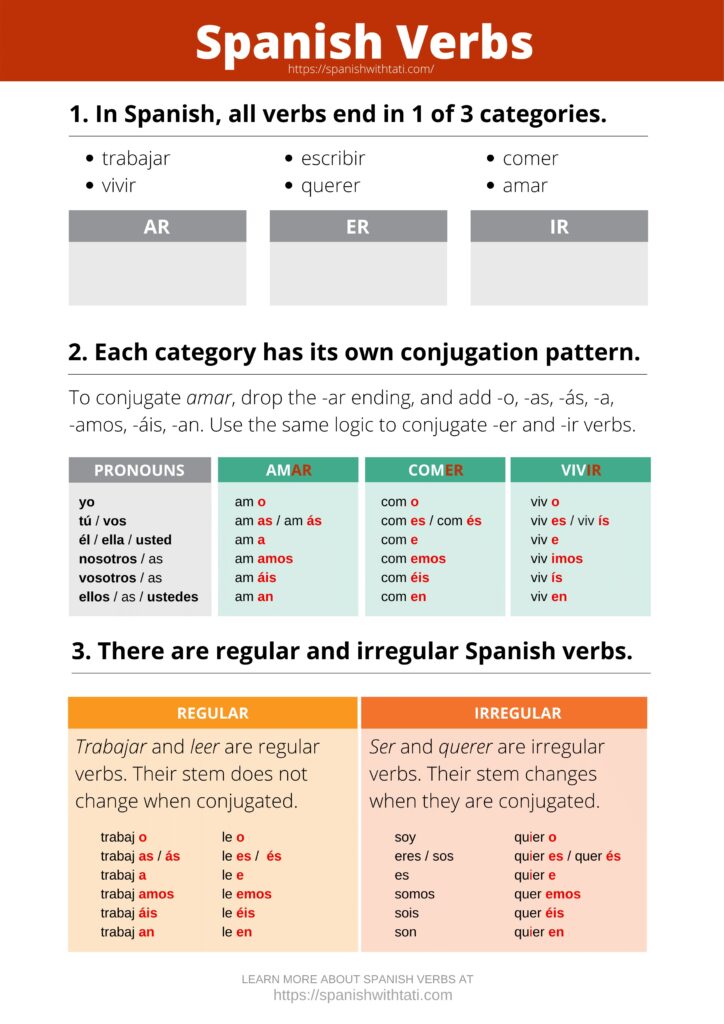
This website includes many free PDF downloads for teachers and students of Spanish. Among these are a cheat sheet for conjugating regular verbs, conjugating irregular verbs, and stem-changing verbs.
List of Common Irregular English Verbs From Language On
A healthy list of English’s common irregular verbs. This is accessible online via the link, or as a downloadable PDF.
Active Verbs List From Oklahoma State University
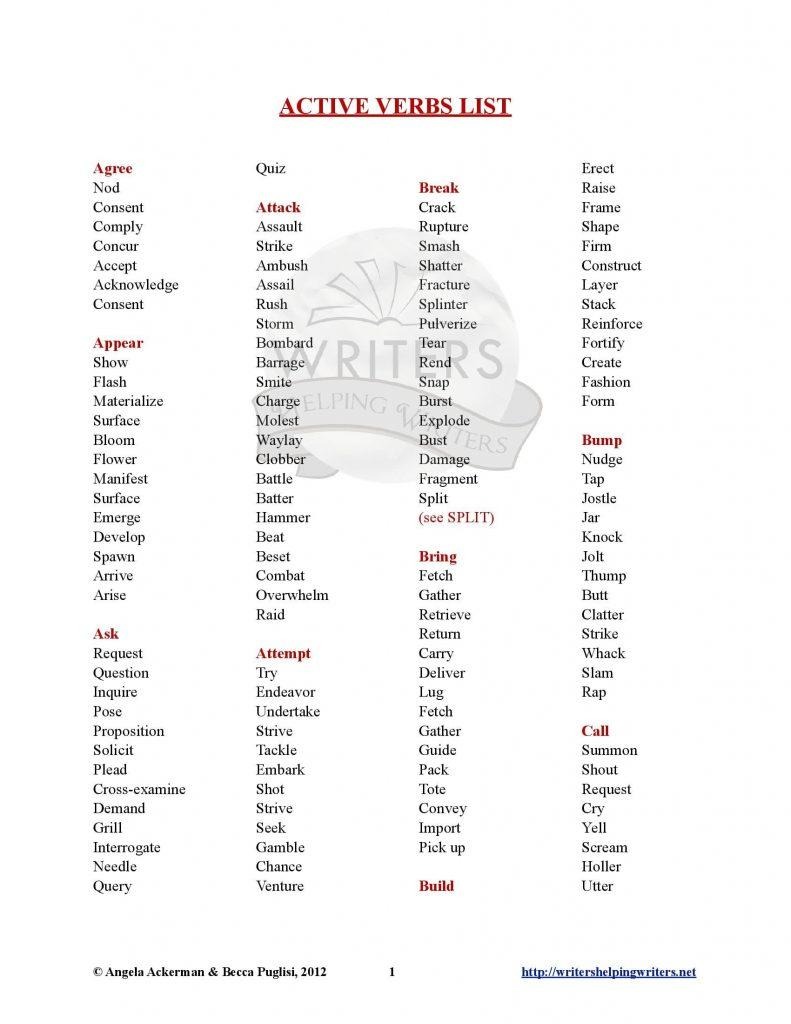
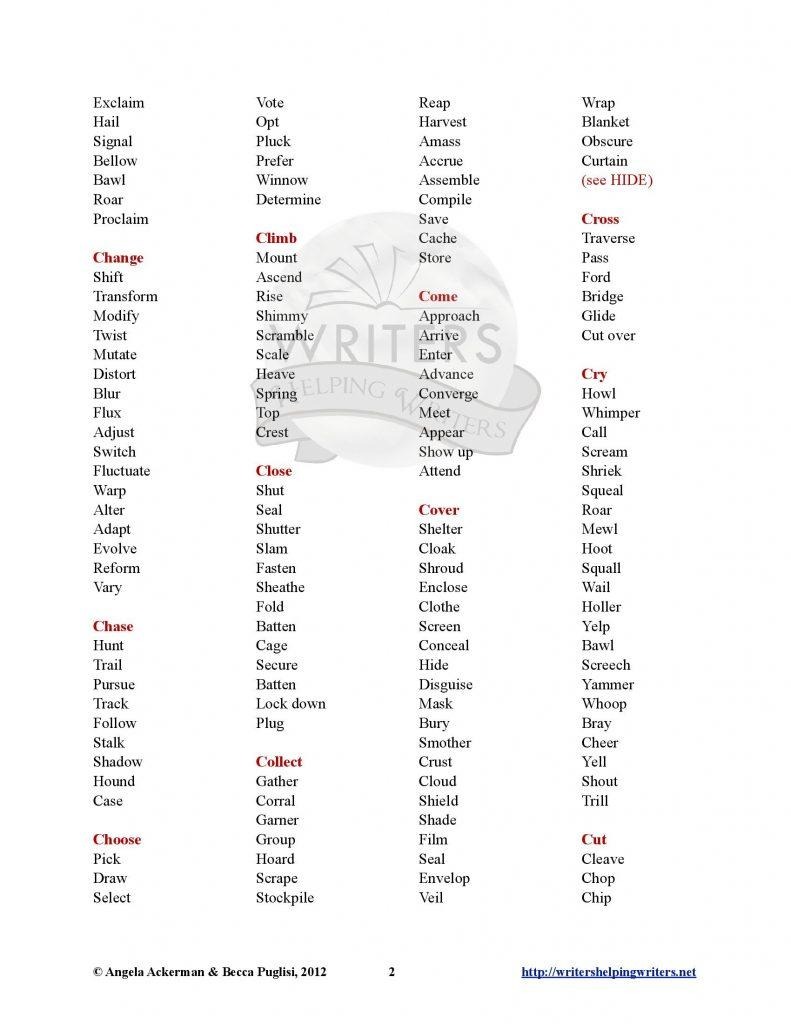
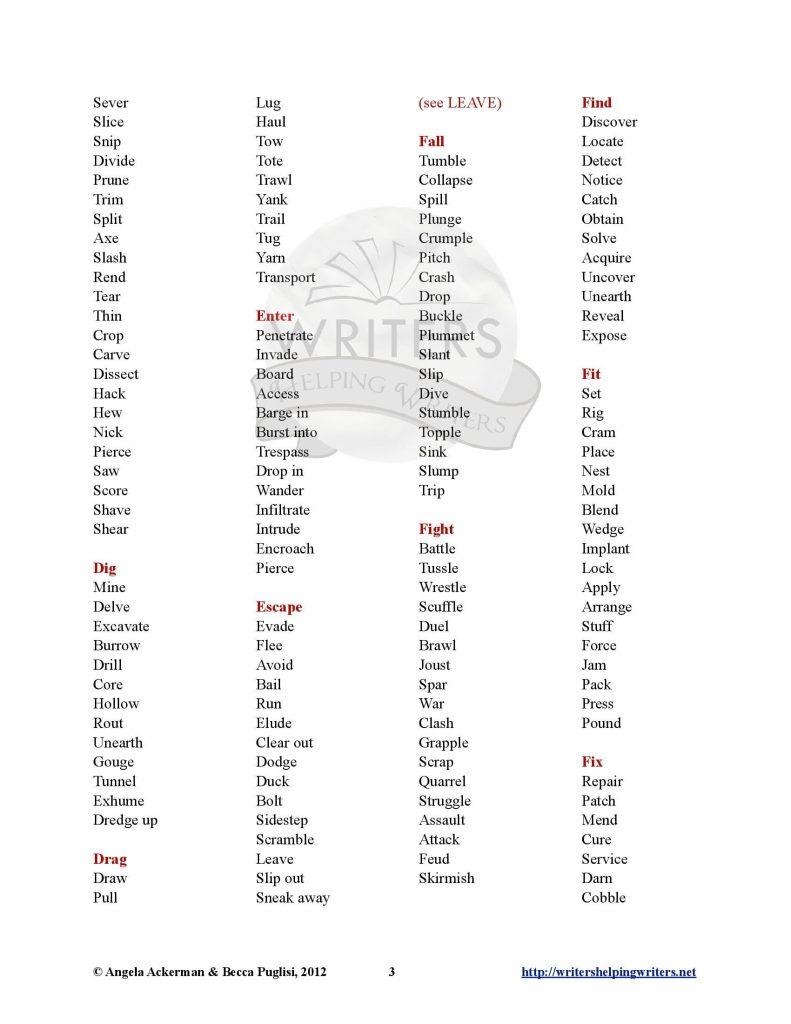
Functioning as a thesaurus for action verbs only, this includes nine pages of action verbs to choose from!
Make Verb Anchor Charts with Your Students
There is already a lot on the walls in your classroom, right? If you were to simply slap an anchor chart on a bulletin board without providing any context, it might not do students much good. If they are involved in the creation of the anchor chart, they will have a deeper understanding of it. Try making your anchor chart with students during class as an interactive writing or shared writing exercise [link to both interactive and shared writing articles], or have students create their own.
Find Somewhere Ideal to Display Your Verb Anchor Chart
If you had your students create their own anchor charts, they could keep these as a page in their binders. If you created a poster, find some easy-to-view real estate on a classroom wall or bulletin board. Keep in mind, anchor charts can be moved or taken down as necessary. Perhaps you only want to display the information for a short period of time. If that’s the case, you can even just write your anchor chart on the whiteboard. It can also be incredibly effective to go over information again and again with your class, and in this case, writing information as your class provides answers each day also makes the whiteboard an effective placement for an anchor chart.
Final Thoughts
Verbs, we use them constantly, and there’s so much to know! It’s important our students learn them well. An anchor chart is a fantastic way to organize information about verbs in a succinct, easy-to-understand manner for our students.
